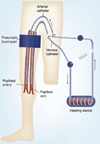Regional therapies for in-transit disease
- PMID: 25769714
- PMCID: PMC5161093
- DOI: 10.1016/j.soc.2014.12.008
Regional therapies for in-transit disease
Abstract
In-transit melanoma is an uncommon pattern of recurrence, but presents unique management challenges and opportunities for treatment. The clinical presentation usually involves from 1 to more than 100 small subcutaneous or cutaneous nodules, ranging from submillimeter to multiple centimeters in diameter. Regional chemotherapy techniques are a mainstay of treatment of patients without systemic disease spread. Future applications of regional therapy are likely to involve combination therapy with cytotoxic agents and novel immune modulators. Regional therapy provides distinct opportunities for the treatment of unresectable disease, and offers a unique platform for investigation of novel therapeutics in early-stage clinical trials.
Keywords: In-transit melanoma; Isolated limb infusion; Isolated limb perfusion; Regional therapy.
Published by Elsevier Inc.
Figures






Similar articles
-
In-transit melanoma: an individualized approach.Oncology (Williston Park). 2011 Dec;25(14):1340-8. Oncology (Williston Park). 2011. PMID: 22329185
-
Current treatment of locoregional recurrence of melanoma.Curr Oncol Rep. 2013 Oct;15(5):465-72. doi: 10.1007/s11912-013-0333-5. Curr Oncol Rep. 2013. PMID: 23907518 Review.
-
Therapy for unresectable recurrent and in-transit extremity melanoma.Cancer Control. 2008 Jul;15(3):225-32. doi: 10.1177/107327480801500305. Cancer Control. 2008. PMID: 18596674 Review.
-
Treatment of melanoma in-transit metastases confined to the limb.Cancer Surv. 1996;26:335-49. Cancer Surv. 1996. PMID: 8783582 Review. No abstract available.
-
Diagnosis and treatment of in-transit melanoma metastases.Eur J Surg Oncol. 2017 Mar;43(3):544-560. doi: 10.1016/j.ejso.2016.10.005. Epub 2016 Oct 27. Eur J Surg Oncol. 2017. PMID: 27923593 Review.
Cited by
-
Correlates of response and outcomes with talimogene laherperpvec.J Surg Oncol. 2019 Sep;120(3):558-564. doi: 10.1002/jso.25601. Epub 2019 Jul 2. J Surg Oncol. 2019. PMID: 31264725 Free PMC article.
-
Clinicopathological Characteristics Predicting Further Recurrence and Survival Following Resection of In-Transit Melanoma Metastases.Ann Surg Oncol. 2022 Oct;29(11):7019-7028. doi: 10.1245/s10434-022-11997-0. Epub 2022 Jun 30. Ann Surg Oncol. 2022. PMID: 35771368 Free PMC article.
-
Tumor Burden and Health-Related Quality of Life in Patients with Melanoma In-Transit Metastases.Cancers (Basel). 2022 Dec 27;15(1):161. doi: 10.3390/cancers15010161. Cancers (Basel). 2022. PMID: 36612157 Free PMC article.
-
In-transit metastatic cutaneous melanoma: current management and future directions.Clin Exp Metastasis. 2022 Feb;39(1):201-211. doi: 10.1007/s10585-021-10100-3. Epub 2021 May 17. Clin Exp Metastasis. 2022. PMID: 33999365 Review.
References
-
- Meier F, Will S, Ellwanger U, et al. Metastatic pathways and time courses in the orderly progression of cutaneous melanoma. Br J Dermatol. 2002;147:62–70. - PubMed
-
- Pawlik TM, Ross MI, Johnson MM, et al. Predictors and natural history of in-transit melanoma after sentinel lymphadenectomy. Ann Surg Oncol. 2005;12:587–596. - PubMed
-
- Cascinelli N, Bufalino R, Marolda R, et al. Regional non-nodal metastases of cutaneous melanoma. Eur J Surg Oncol. 1986;12:175–180. - PubMed
-
- Kang JC, Wanek LA, Essner R, et al. Sentinel lymphadenectomy does not increase the incidence of in-transit metastases in primary melanoma. J Clin Oncol. 2005;23:4764–4770. - PubMed
-
- Morton DL, Thompson JF, Cochran AJ, et al. Sentinel-node biopsy or nodal observation in melanoma. N Engl J Med. 2006;355:1307–1317. - PubMed
Publication types
MeSH terms
Substances
Grants and funding
LinkOut - more resources
Full Text Sources
Other Literature Sources
Medical

